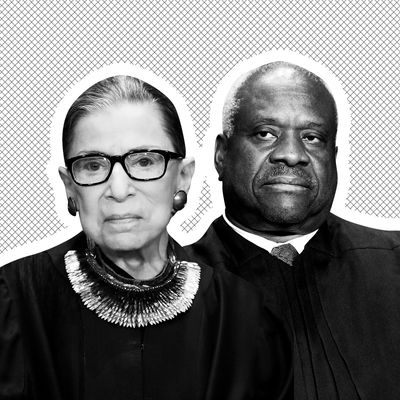
The lace gloves are off; by the cramped standards of Supreme Court decorum, Ruth Bader Ginsburg might as well have smacked Clarence Thomas across the face with one of them. It all went down in the footnotes of a mixed ruling today on Indiana’s abortion law, suggesting the shape of the abortion battle to come.
Signed by Mike Pence in 2016, the law requires either burial or cremation of fetal remains after an abortion, and bans abortion if the reason is race, sex, or disability. A federal court of appeals promptly pointed out that under decades of Supreme Court holdings, legislators can’t police the reasons why people have abortions, as long as it’s before the fetus can survive on its own. We’ve been waiting for months for the highest court to have its say. On Tuesday, in an unsigned opinion, it signed off on the burial requirement, but declined to get involved with the state’s propagandistic ban on certain reasons for abortion.
The ruling had the makings of a compromise. The court effectively split the difference and, for now at least, kept abortion off its agenda in a presidential campaign season. Even Thomas begrudgingly conceded that maybe it was too soon for the court to get involved on whether women should be prevented from having abortions if the doctor thinks disability, race, or gender is the reason. But he still wanted to take the opportunity to stigmatize abortion and people who have them. He issued a 20-page, furious disquisition on the history of eugenics, birth control (yes, birth control), and abortion, effectively inviting legislators to pass more laws like Indiana’s so the court can properly jump into that fray. “Enshrining a constitutional right to an abortion based solely on the race, sex, or disability of an unborn child, as Planned Parenthood advocates,” Thomas wrote, “would constitutionalize the views of the 20th-century eugenics movement.”
He also took aim at Ginsburg, who wrote a partial dissent arguing that the court shouldn’t have allowed the fetal-remains law to go into effect, because it violated women’s rights. “Justice Ginsburg’s dissent from this holding makes little sense,” Thomas complained in a footnote to an extraordinary 20-page rant on abortion and eugenics, adding that her “argument is difficult to understand.” Ginsburg replied to Thomas’s footnote with her own footnote, saying it “displays more heat than light,” and “overlooks many things.”
Anywhere else, this might be tea and crumpets, but at the Supreme Court, it means war. In the past few weeks, that war has been between visibly furious liberal justices, and Thomas, whose default mode is bitterness. Witness the normally cool-blooded Justice Stephen Breyer’s dour, unmistakably abortion-related warning just a few weeks ago that the court was too eager to overturn precedent and his earlier fury at how the court handled a death-penalty case. As for Ginsburg, even when she deploys the dissent collar, she rarely attacks her colleagues’ work so directly.
The stakes go beyond mere words. The stakes are Roe v. Wade, and everything that came after it affirming a legal right to abortion, plus a host of other precedents that Thomas openly abhors. He has been daring his conservative colleagues to just go after abortion already, accusing them of cowardice when they demur. His liberal ones, on the other hand, are apoplectic.
The TL;DR on Thomas’s opinion, and the law that he was riffing on, is that anti-abortion activists have looked to exploit a real and painful American history of reproductive control used for racist and ableist ends, or to invent an epidemic of sex-selective abortion that doesn’t actually exist in the United States, but would effectively force doctors to police Asian-American women. Thomas cited high abortion rates in the black community — which clearly relate to broader disparities in health care and socioeconomic status — to suggest a racist conspiracy related to the eugenic flirtations of Planned Parenthood founder Margaret Sanger. (You can read Imani Gandy’s nuanced debunking here.) Twenty pages later, Thomas hasn’t quoted a single black women on the subject of reproductive choices, despite the fact that the Indiana law requires believing that black women are discriminating against their own embryos or fetuses, or have been tricked by white people into doing so. As reproductive-justice activist Renee Bracey Sherman tweeted, this trope is “the fastest way for white supremacist anti-abortion advocates to point to us being The Real Racists™ without having to actually engage with Black people about what our lives are like.”
Ginsburg decided not to take the bait on most of this. She did correct some of Thomas’s terminology: “A woman who exercises her constitutionally protected right to terminate a pregnancy is not a ‘mother,’” she said, though she declined to engage Thomas on his repeated use of “aborted children.” Ginsburg also pushed back at some of her colleagues (except Sonia Sotomayor, who also dissented) being willing to put abortion patients through additional hurdles about how the remains of their pregnancy should be treated, because “the cost of, and trauma potentially induced by, a post-procedure requirement may well constitute an undue burden.”
For a moment Tuesday, the court let us into some of the behind-the-scenes conflict it normally keeps under the robes. With legislators loading cannons with anti-abortion laws aimed squarely at the court and Thomas eager for a fight, it won’t be the last time.


